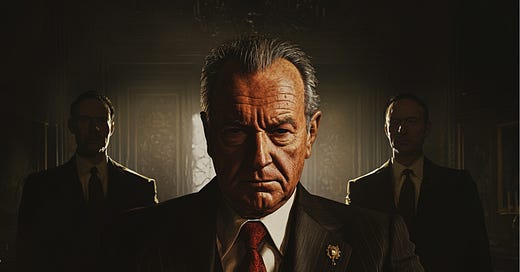Breaking Down the Code: How Crime Families Operate
Behind every criminal empire is a code—a structure that governs its operations, ensures loyalty, and keeps the machine running smoothly. Whether it’s the infamous Five Families of New York or the Marcuccios of South Philadelphia, the foundation of organized crime lies in its hierarchy.
Understanding how these families operate is like learning the rules of a game—once you see the moves, everything starts to make sense. Let’s break it down, piece by piece, using the Marcuccio crime family as our lens.
The Hierarchy of Power
Organized crime families function like corporations, with defined roles and responsibilities at every level. Here’s a closer look:
1. The Boss
The boss is the kingpin, the ultimate authority in the family. Every major decision—whether it’s a hit, a deal, or a partnership—goes through them. Since Giuseppe Marcuccio’s death on June 23, 1996, his trusted underboss, Don Donatello, has held the reins as the boss of the Marcuccio crime family. Known for his quiet, calculating demeanor, Donatello exemplifies the modern mafia boss: someone who rules through respect rather than brute force.
The boss doesn’t get their hands dirty. They delegate, protect their image, and ensure the family’s interests are preserved. But make no mistake—their word is law.
2. The Underboss
Second in command, the underboss is the boss’s right-hand man, managing the family’s day-to-day operations.
During Giuseppe Marcuccio’s reign, this role belonged to Don Donatello, whose loyalty and strategic mind earned him the position. Today, under Don Donatello’s leadership, the underboss is Dominick Graziano. Graziano is known as a steady hand, ensuring that the Marcuccios’ operations continue to run smoothly despite law enforcement pressures and rival family conflicts.
The underboss is often seen as the heir apparent, ready to take over if the boss steps down—or is removed.
3. The Consigliere
The consigliere is the advisor, often operating in the shadows. They’re not directly involved in the dirty work but serve as a strategist and confidant to the boss. In many ways, the consigliere is the family’s conscience, offering advice on diplomacy, internal disputes, and navigating law enforcement pressures.
Today, Salvatore Trillo holds this role, having been appointed in the early 2000s. Trillo is a seasoned player in the Marcuccio organization, known for his sharp mind and ability to diffuse tensions both within the family and with external rivals.
4. The Caporegimes (Capos)
Capos are the middle managers of the family, each overseeing a specific crew. They’re responsible for a group of soldiers and associates, ensuring the family’s operations in their territory run efficiently. Capos collect money from their crews and kick it up to the boss, keeping a cut for themselves.
The Marcuccio family’s South Philly Crew is run by Vito Caputo, widely recognized as the enforcement arm of the organization. Caputo is known for his no-nonsense approach to loyalty and discipline, ensuring the family’s dominance on the streets.
Another prominent capo is Flavio Gambino (no relation to Carlo Gambino), who oversees the Pennsport Crew. Gambino’s operations focus on smuggling and racketeering, making him a critical figure in maintaining the family’s financial stability.
5. The Soldiers
The backbone of any family, soldiers are made men who carry out the orders of their capo. They’re the ones collecting debts, running rackets, and sometimes handling violent enforcement. To become a soldier, one must be initiated—a process that involves pledging loyalty to the family for life.
Tony Costa, a soldier under the Marcuccios, exemplifies this role. With decades of experience in labor racketeering, Costa has earned respect within the family for his dedication and savvy.
6. Associates
Associates are not full members of the family but work with them, often in hopes of earning their way in. They can be anyone from corrupt politicians to low-level criminals. Associates are valuable assets, but they’re expendable if they pose a risk to the family.
The Marcuccios, like any family, rely heavily on associates to expand their reach and avoid direct involvement in risky operations.
The Code That Binds Them
At the heart of any organized crime family is the code of conduct. The rules are simple but unforgiving:
Loyalty Above All
Betrayal is the ultimate sin. Disloyalty often results in swift and brutal consequences.Silence is Sacred (Omertà)
Never cooperate with law enforcement. To speak out is to invite death, not just for yourself but for your loved ones.Respect the Chain of Command
Orders flow down from the top. Defiance is met with punishment.Never Cross the Family
Personal disputes must never endanger the family’s operations or reputation.
Why It Matters
Understanding this structure isn’t just a matter of curiosity—it’s essential to decoding the influence of organized crime. Every move, from a small-time extortion scheme to a high-level political bribe, follows this hierarchy.
In the Marcuccio family’s world, these roles have allowed them to survive wars, federal crackdowns, and internal betrayals. The structure isn’t just a system; it’s their lifeline.
The next time you hear about a mafia family, remember this: their power doesn’t just come from violence or money. It comes from the code that holds them together, a code as old and unyielding as the streets they control.
Stay vigilant,
Will Ryland
What do you think about the code of organized crime? Do you see parallels to other systems of power? Share your thoughts in the comments below—I’d love to hear your take.










